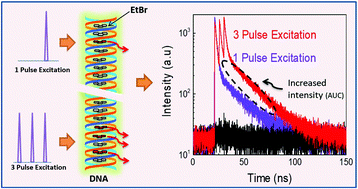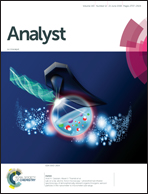Enhanced DNA detection using a multiple pulse pumping scheme with time-gating (MPPTG)†
Abstract
Fluorescence signal enhancement induced by the binding of intercalators to DNA has been broadly utilized in various DNA detection methods. In most instances the increase in fluorescence intensity is associated with a concomitant increase of fluorescence lifetime. This increase of the fluorescence lifetime presents an additional opportunity to increase detection sensitivity. In this paper, we present a new approach to significantly enhance the sensitivity in detecting minute DNA concentrations. The approach is based on simultaneous use of time-gated detection and multi-pulse pumping. By using a calibrated burst of short pulses we greatly enhance the contribution of long-lived fluorescence species, thus enabling easy time-gated detection. Using a classic DNA intercalator – Ethidium Bromide (EtBr) – as an example with our novel multi-pulse pumping and time-gated detection technique, we were able to increase detection sensitivity over 70-fold with only 3 pulse excitation. This approach is generic and can be used with any analytical probe (exhibiting about 10 times change in lifetime) that shows an increase in fluorescence signal and fluorescence lifetime upon binding to a target.



 Please wait while we load your content...
Please wait while we load your content...
